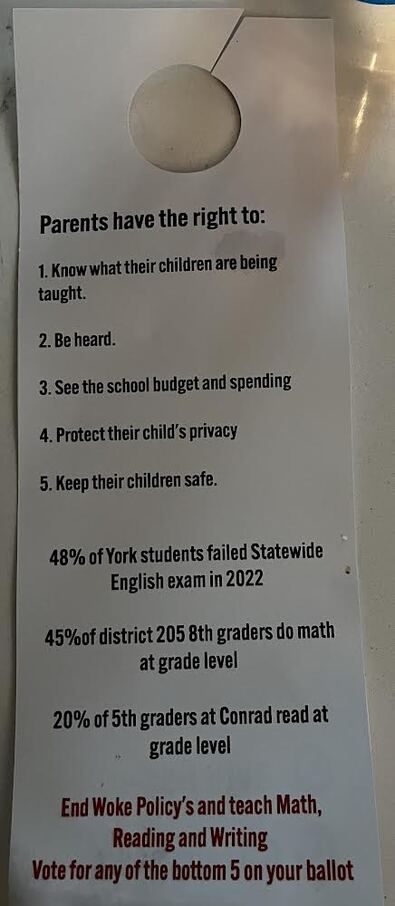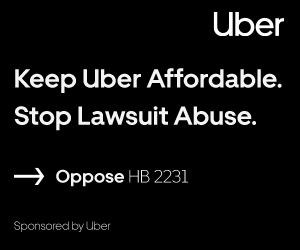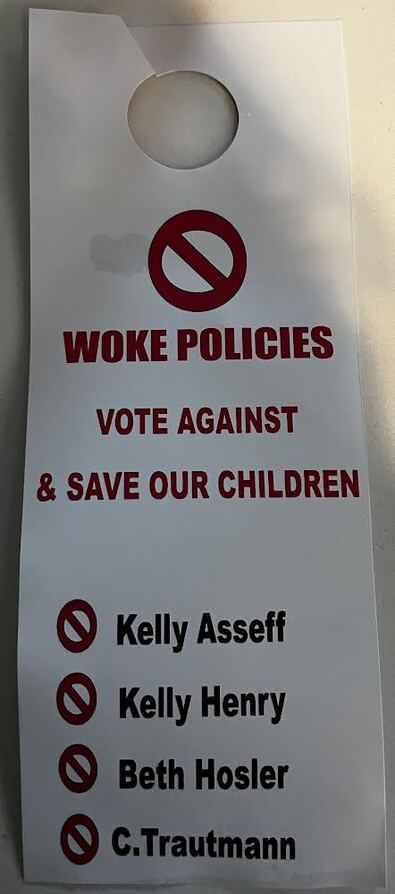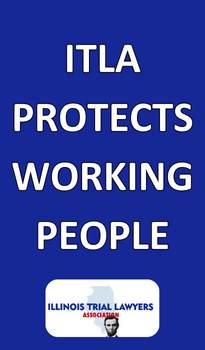|
*** Live election night coverage ***
Tuesday, Apr 4, 2023 - Posted by Rich Miller * Live updates and results from various media outlets…
* Chicago Tribune * Crain’s Chicago Business * WGN TV * NBC 5 * CBS 2 * State Journal-Register * Daily Herald If you find anything I’ve missed, please let me know in comments. Some outlets just didn’t have anything in place as of late this afternoon. * I’ll adjust this live tweet list as we go along, adding or subtracting as necessary. You’ll likely see a bit of off-topic content here until the polls close and votes start to come in…
|
|
Afternoon roundup
Tuesday, Apr 4, 2023 - Posted by Rich Miller * Mathematically challenged…
* Wow…
* Chicago…
There will be a live coverage thread tonight right here on the blog. * Oh my…
* Universally derided…
* Help our guy out, please…
* Isabel’s roundup…
* Sun-Times | 5 students in custody after reports of possible gun at Highland Park High School: Five students were taken into custody after Highland Park High School was placed on lockdown Tuesday for reports of a student “potentially in possession of a gun.” There were no reports of shots fired but students and staff were ordered to remain in place while police secured the building, according to a statement posted on the city’s Facebook page. * Lake County News-Sun | Father of alleged Highland Park parade shooter back in court; judge prods lawyers to move case along: Judge George Strickland, who is hearing the case against Robert Crimo Jr., asked his attorney and prosecutors to try to complete the discovery phase of the case, if possible, by the next hearing. Crimo Jr. is scheduled to appear again on June 14. * Sun-Times | FOP boss files complaint about city housing migrants at police stations: Catanzara said “it’s inhumane” for the city to relegate migrants to sleeping on “hard floors night after night,” insisting they “should not be camping out there indefinitely like a homeless shelter.” He said officers shouldn’t have to work in those conditions, either. * SIU | SIU’s Paul Simon Institute to host ‘rising star’ Illinois state Rep. Margaret Croke: The series will feature new leaders who are “already shaping the Prairie State and are poised to become increasingly influential,” Shaw said. The institute will host, both virtually and in person, young leaders from the Illinois General Assembly, mayors, and members of city councils, county commissions and school boards. * Crain’s | Chicago health chief touts record on mental health: Chicago Department of Public Health Commissioner Dr. Allison Arwady said Tuesday that she’s committed to remaining in public health and proud of her progress on improving mental health over the past four years. Arwady responded to the news that mayoral candidate Brandon Johnson does not intend to keep her in the role if he wins today’s election. While Arwady says she would prefer to remain leading CDPH in the next administration, Johnson would change course. * WICS | Illinois AG warns resident for storm-related repair scams: Raoul cautioned residents that scammers often move quickly into communities to take advantage of people with damage to their homes or businesses. Raoul noted these “storm chasers” use the opportunity to pressure people into making quick and often expensive decisions about cleanup and construction work. Raoul also warned residents that scam artists may be operating as public adjusters who offer “free” inspections to submit a claim to property owners’ insurance companies. * Bloomberg | This key Wisconsin race will show just how important abortion is to voters: Liberal Democrats hope to take control of the Wisconsin State Supreme Court for the first time in 15 years Tuesday with a win by Janet Protasiewicz, who is favored over Republican-backed Daniel Kelly, after the state Democratic Party and outside groups poured money into the race. * Bloomberg Opinion | Too much of America is emptying out. More immigration can help.: The situation is much worse for places that were affordable before the pandemic. Cities and towns in rural Midwest that lose people are looking at a larger fiscal loss, because there’s no guarantee people will return even at lower prices. They could adjust to the smaller population by raising taxes, but that won’t exactly help attract new residents. A permanent loss of population will be a blow to local businesses, too, which will further reduce government revenue. * Pew | U.S. journalists’ beats vary widely by gender and other factors: Men account for 83% of the surveyed journalists who indicated that they cover sports, far higher than the 15% who are women. Men also account for majorities of those who cover political news (60%) and news about science and technology (58%). By comparison, women are more likely than men to cover three of the 11 news beats studied: health, education and families, and social issues and policy. For instance, women account for nearly two-thirds (64%) of surveyed journalists who cover news about health, while only about a third (34%) are men. * Sun-Times | White Sox’ Liam Hendriks announces he’s starting last round of chemo: Cult hero A.J. Pierzynski threw the ceremonial first pitch, and Grammy Award-winning artist Jon Secada sang a passionate rendition of the national anthem. But the most uplifting moment before the White Sox’ home opener Monday was a brief message from closer Liam Hendriks, who provided an encouraging update after disclosing Jan. 8 he was undergoing treatment for non-Hodgkin lymphoma. * AP | NASA names astronauts to next moon mission, first crew under Artemis: “We are going back to the moon and Canada is at the center of this exciting journey,” said the Honorable François-Philippe Champagne, the minister responsible for the Canadian Space Agency. “Thanks to our longstanding collaboration with NASA, a Canadian astronaut will fly on this historic mission. On behalf of all Canadians, I want to congratulate Jeremy for being at the forefront of one of the most ambitious human endeavors ever undertaken. Canada’s participation in the Artemis program is not only a defining chapter of our history in space, but also a testament to the friendship and close partnership between our two nations.”
|
|
IEA says school board candidate banned from school district property, and other stories from the front
Tuesday, Apr 4, 2023 - Posted by Rich Miller * From the IEA…
…Adding… As noted in comments, Kristina Konstanty was endorsed by Awake Illinois yesterday. * Last week…
1776 Project PAC mailer… 
* On to these unusual doorhangers in the Elmhurst area, which Isabel told you about yesterday. Notice that they have no “Paid for by” notification on them… 
“Vote for anyone except these people,” is a different way of doing things. They even have a website…
Some folks sure are upset about equity. Also, note how they claim these liberals are somehow book burners…  And not a single “Paid for by” on the site that I can find.
…Adding… Tom Chavez, Lan Li, Linda Nudera and Jammie Esker Schaer were all endorsed by Awake Illinois yesterday. * Isabel’s roundup… * : In Illinois, this ideological battle is on full display in Tuesday’s elections as residents throughout the state vote in mayoral and school and library board elections. Local school and library board elections, nonpartisan by design, now are subject to credible threats from candidates intent on furthering exclusionary policies such as book bans and opposition to diversity, equity and inclusion policies. The Democratic Party of Illinois has made an unprecedented commitment of $300,000 to combat them. * Pantagraph | Meet the District 87 school board candidates: The four candidates for the Bloomington District 87 school board spoke with The Pantagraph recently about their priorities and goals if elected during Tuesday’s election. * Patch | 9 Candidates Up For 4 Seats On District 200 Board: Nine candidates are in the running for four seats on the Community Unit School District 200 Board of Education. Two candidates are facing off for one unexpired two-year term and seven are vying for three open seats with full four-year terms. * Patch | 4 Vie For 3 Seats On Palos Dist. 118 School Board: Four candidates running for three open seats on the Palos Dist. 118 school board in the April 4 consolidated election. Two candidates out of four responded to the Patch candidate questionnaire. * Patch | ETHS, D-65 Elections: Who Will Be Elected To Evanston School Boards?: With only two incumbents running for three open seats on each of Evanston’s public school boards, there are bound to be new faces elected on Tuesday in Evanston/Skokie School District 65 and Evanston Township High School District 202. * Patch | Nothing Quiet About D86 Board Race: Three of the candidates, Kay Gallo, Catherine Greenspon and Andrew Catton, are outspoken critics of Superintendent Tammy Prentiss, who was promoted in 2019. Like the other three, candidate Asma Akhras criticized the way Prentiss handled a high-profile incident involving an anti-racist consultant. Still another, Deborah Willoughby, praised the superintendent in a Patch questionnaire. * Patch | 4 Vie For 3 Seats On Plainfield D202 Board Of Education: The candidates are Savena Joiner, Elias Kalantis, Margarita Morelos and Heather Roach. The only incumbent is Roach, who was first elected to the position in 2015 and reelected in 2019. Kevin Kirberg, who currently serves as Board president, and Treasa Howard-Collins are not seeking reelection. * Patch | Progressives Vs. Conservatives In Elmhurst D205: During the pandemic, Elmhurst school board meetings became battlegrounds over issues such as school shutdowns, masks and critical race theory. Public comments at times became heated. At one meeting, the board recessed for about five minutes when mask mandate backers shouted down a public commenter who refused to wear one. * Patch | 6 Vie For 3 Seats On Mokena 159 Board Of Education: According to candidate questionnaires submitted to Patch, Tunney is the lone candidate with school governance experience and is the current President of the Mokena PTA. Coleman and Fryer did not respond to multiple requests from Patch to submit questionnaires. * Patch | 8 Candidates Run For 3 LTHS Board Of Education Positions: Tylka-Shaw and Lewandowski are both incumbent board members. Tylka-Shaw serves as secretary of the board, and was elected in 2019. Lewandowski has served on the board since 1999. According to the District website, Lewandowski is an LTHS alumnus and “wants to provide a safe and secure environment to educate all LTHS students and to continue to work with the administration to establish goals for improving student achievement.”
|
|
Caption contest!
Tuesday, Apr 4, 2023 - Posted by Rich Miller * From Daniella Mazzio… 
|
|
*** UPDATED x1 *** Afternoon precinct reports
Tuesday, Apr 4, 2023 - Posted by Rich Miller * Hope everyone is OK…
More here. * Hopefully, things are a lot calmer near you. What’s going on out there? *** UPDATE *** Over…
|
|
Freedom Caucus claims to be “exploring an ethics complaint” over potential rules violation, while member asks top justice about recusals in gun case
Tuesday, Apr 4, 2023 - Posted by Rich Miller * Just FYI, but the Republicans knew the Democrats were losing members as 3rd Reading deadline night progressed (they even asked to verify roll calls that evening), but waited until after all their bills had been voted on before asking for a roll call verification of the very last bill on the House’s 2nd Reading calendar. Also, if it hadn’t been for the Freedom Caucus’ rule change dumping the consent calendar for substantive bills, the House might not have been in so late. By one count, 283 of the 465 bills the House passed garnered at least 100 votes. Also, staff voting members’ switches is a bipartisan thing, but we’ve seen controversy about this before (remember “Buttongate”?). It’s not a legal violation, but it is a rules violation and the folks back home probably do not love the practice, so here you go…
* From Speaker Chris Welch’s spokesperson Jaclyn Driscoll…
* Background is here if you need it, but Freedom Caucus member Rep. Brad Halbrook serves on the House Appropriations-General Service Committee. And Illinois Supreme Court Chief Justice Mary Jane Theis testified at the committee about her budget request today. Rep. Halbrook then asked her this question…
As another FYI, Supreme Court candidates are not allowed to personally solicit campaign contributions. But as a recent motion filed by the attorney for Rep. Caulkins noted, G-PAC and Giffords PAC endorsed both high court candidates and had this explanation on its website…
A G-PAC spokesperson declined comment.
|
|
Keep Uber Affordable. Stop Lawsuit Abuse. Oppose HB 2231
Tuesday, Apr 4, 2023 - Posted by Advertising Department [The following is a paid advertisement.] 
|
|
That toddlin’ town roundup
Tuesday, Apr 4, 2023 - Posted by Rich Miller * You could hardly get more different results if you tried. As the crosstabs show, this IZQ poll vastly differs with the Victory Research poll on men and on race. VR had Vallas up by 13 points among men. The IZQ poll has them tied, 48-48. VR had Vallas leading among whites 76-19, the IZQ poll has Vallas up by just 10, at 54-44. VR had Johnson up among Black voters 76-20 with 3 percent undecided, but this IZQ poll has Johnson leading 64-22 with 14 undecided. VR had Vallas up 50-43 among Latino voters, while this IZQ poll has Vallas up by 17 points. Also, the VR poll had the two tied among those who had voted and had Vallas leading 50-43 among those who hadn’t yet voted, while this poll had large Johnson leads among early voters and had Vallas leading by just 4 points among those who were waiting until today. And, according to this poll, Vallas is still stuck at 45..
* Meanwhile…
* And…
…Adding… Heh…
* Isabel’s roundup… * Tribune | Election Day in Chicago: Voters will choose Brandon Johnson or Paul Vallas as city’s next mayor, with a tough job awaiting the winner: Vallas, a 69-year old former schools chief, has long been a critic of the Chicago Teachers Union that Johnson helps lead, asserting the union’s work stoppages during the pandemic harmed children’s well-being and hurt their growth for generations. Johnson, 47, regularly paints Vallas’ approach to public education as “morally bankrupt” for his promotion of private school vouchers and expansion of charters across the country. * Sun-Times | Chicago Runoff Election 2023: Live results, voter reactions and news updates: Try not to hold your breath for the final outcome. The winner may not be known for days. “I highly doubt either camp will concede on election night because up to 100,000 votes may not be counted when we go to bed on election night,” said pollster Matt Podgorski of M3 Strategies, whose polling correctly placed the top four finishers in Round One of the mayoral sweepstakes within roughly half a percentage point. * Tribune | Early voting is up in runoff compared to February but overall voter turnout remains unclear: Through Sunday night, about 155,000 people voted early in person, while 95,000 had turned in their mail ballots for a total of nearly 250,000 ballots cast. In the February election, the total number of ballots cast two days before Election Day was a little more than 211,000. After all mail ballots were counted, February turnout was 36%, slightly higher than both rounds of the 2019 election, but lower than the 2011 election and the runoff in 2015, when it was 41%. * NBC Chicago | 7 City Council Races to Watch in the 2023 Chicago Runoff Election: The race to replace Ald. Roderick Sawyer was closely-watched throughout the campaign, and William Hall and Richard Wooten earned spots in the runoff, finishing just 71 votes apart. Hall was endorsed by Illinois Gov. J.B. Pritzker in the first round of voting, and also received support from the SEIU and Chicago Teachers Union. * Tribune | Chicago’s runoff election: Everything you need to know about races for mayor and aldermen: In the 14 races for City Council that have not yet been decided, six involve incumbents who didn’t exceed the 50% threshold, three of whom Mayor Lori Lightfoot recently appointed to the seats. * ABC Chicago | Chicago Election 2023: Full coverage of mayoral race, city council seats and more: As of about 9 a.m., there have been 304,090 total ballots cast, a 19.1% total citywide turnout so far. * Crain’s | Keep a close eye on these signals in today’s mayoral vote: So far, turnout in early and mail-in ballots has been significantly higher than in the past two mayoral general elections. That likely helps Vallas since Johnson has a much better field operation that Vallas needs to offset by having big numbers of voters turn out on their own. That’s also the main reason why polls and political insiders are giving Vallas a small edge. But if the weather tomorrow is as bad as the weather folks say — damaging storms with high winds and pelting rain are in the forecast — turnout could drop. But if the storms don’t hit until, say, 4 p.m. — or if more people vote early today — it may not matter. * Politico | The final hours of Chicago’s too-close-to-call mayoral runoff: The issues of crime and policing have dominated the runoff election, which was necessary because no candidate earned a majority of the vote in the first round of voting back in February. Vallas (33 percent) and Johnson (22 percent) finished first and second, respectively, while Lightfoot (17 percent) was eliminated after a third-place finish. * South Side Weekly Op-Ed| There is No Ethical Path to Voting for Paul Vallas: This election is not rare in having two imperfect candidates squaring off. It is rare because the battle we face is rooted in the eternal American debate about race and our history, and carries huge implications for the future of our country. In this debate, there is no ethical path that allows a vote for Paul Vallas. * Sun-Times | Rep. Jesus ‘Chuy’ Garcia’s daughter, 28, dies: “Last night our beloved daughter, Rosa, passed away at the age of 28. We are completely heartbroken,” Garcia said. * Chalkbeat | Chicago staffs fewer National Board certified teachers as it pushes to grow their ranks:A Chalkbeat analysis found the overall number of board-certified teachers has decreased steadily, even as the number of educators Chicago Public Schools employs has grown. About 1,000 of the district’s more than 22,000 educators are board-certified, down almost 30% since 2016. * WGN | Police payouts soaring in city of Chicago: The city of Chicago has paid more than $578 million since 2016 in judgments, settlements and legal fees relating to claims of police misconduct. It is a staggering figure but observers say taxpayers aren’t done paying yet. They predict millions of dollars more will be spent as legal cases relating to a notorious former officer wind through the courts. * Block Club | Greektown Starbucks Workers Win Union Election, Become Chicago’s 8th Unionized Shop: The Greektown cafe is the eighth unionized shop in Chicago and one of more than 250 unionized shops nationwide. A ninth unionized shop in Edgewater closed in October right as workers were scheduled to begin contract negotiations. * Sun-Times | Firefighter killed, 2 others hurt at extra-alarm fire in West Pullman: Pelt joined the Chicago Fire Department in 2005 and was based on the South Side his whole career, according to Nance-Holt. He had celebrated a birthday in March and just walked his older daughter down the aisle. She was on her honeymoon at the time of the incident. Pelt’s younger daughter is 6 years old. * Block Club | Midtown Athletic Club’s Cleaning Staff Spoke Out About Safety Concerns. Then, 33 Workers Were Fired: A member of the Bucktown gym joined protesting workers this weekend. “I ask Midtown, why not show the same care and respect to your employees that you show for your members?” * Chicago Mag | A Very Daley Tour of Bridgeport: What’s the point of being mayor if you can’t guarantee yourself the best police and fire protection? The police station on the corner of Daley’s block housed the limousine that drove him to City Hall every morning and the squad car that guarded the alley behind his house. The police district has relocated to a modern building on Halsted Street, but the firehouse remains. * WTTW | Family-Owned Chicago Flag Company Has Been Supplying Symbols of Civic Pride for 108 Years: “We were here long before TV, we were here long before radio. W.G.N. Flag and Decorating Company, since 1916 and named after the family. Yeah, unfortunately those media outlets have nothing to stand on. I love ‘em but we were here first,” said Carl “Gus” Porter III. “The company actually started by my great grandfather purchasing a stick flag from a street merchant, walking down the street, and selling it for twice what he paid for it.”
|
|
Hold Uber Accountable. Support HB 2231.
Tuesday, Apr 4, 2023 - Posted by Advertising Department [The following is a paid advertisement.] 
|
|
ComEd 4 trial coverage roundup
Tuesday, Apr 4, 2023 - Posted by Isabel Miller * Here you go…
* Crain’s | One conversation gets as close to the quid for the quo as ‘ComEd Four’ trial has gotten: With that summation, McClain in that call undermines much of what the defense has presented so far in terms of how Madigan helped ComEd in Springfield. Attorneys repeatedly have said Madigan’s staffers drove hard bargains in negotiations with ComEd and Exelon and didn’t give in to their initial requests. In one example, Madigan’s aides in 2016 talked Exelon down from a subsidy of $285 million annually for two nuclear plants that otherwise would close, to $235 million, according to evidence the defense presented. Over the 10 years of that subsidy — which ratepayers statewide still are paying in their electric bills — that translated into more than $2 billion. * Tribune | ‘We had to hire these guys‘: Jury in ‘ComEd Four’ trial hears recordings laying out role of Madigan’s confidant as go-between for utility: On another call from February 2019, McClain boasted to an Exelon executive he’d been doing “assignments” for Madigan for 25 years and “you’ve never read about me in a newspaper.” The recordings, which were played back-to-back for an hour without a witness on the stand, featured a who’s who of Madigan’s most trusted associates, including 13th Ward Ald. Marty Quinn, former state Rep. John Bradley, former top staffer-turned lobbyist Shaw Decremer, as well as the speaker’s son, Andrew. * Center Square | ‘ComEd Four’ video evidence shows effort ‘to keep Mike Madigan happy’: An undated recording has McClain talking with Madigan, who’s on trial for the alleged scheme next year, about various associates. “When you’re with Anne, you’re talking about Mike Zalewski,” Madigan said. “Mike Zalewski and Juan Ochoa, and Joe Dominguez,” McClain said. “Those are the three.” * Telephone conversation between Michael McClain and John Hooker and Anne Pramaggiore | ComEd Exhibit 136-T: PRAMAGGIORE: Well and they, and they gotta you know the other thing Michael is, you know this is, this is a different group that they have to deal with inside the company, and you have to have somebody who knows, that the, the Speaker trusts, and can sort through this stuff to make sure that the right information is flowing.
|
|
Protected: SUBSCRIBERS ONLY - Today’s edition of Capitol Fax (use all CAPS in password)
Tuesday, Apr 4, 2023 - Posted by Rich Miller
|
|
Open thread
Tuesday, Apr 4, 2023 - Posted by Isabel Miller * It’s Election Day! What’s going on in your part of Illinois?… …Adding… [From Rich] Let’s also use this post as a morning precinct report. What are you seeing out there? Let us know where you are if you can. …Adding… Fresh thread is here.
|
|
Isabel’s morning briefing
Tuesday, Apr 4, 2023 - Posted by Isabel Miller * Here you go!…
* Sun-Times | Secret ‘risk rankings’ unfairly target struggling customers for faster gas, electricity cutoffs, consumer groups say: Illinois electric and gas companies are quietly sorting their customers into different “risk” categories that could mean faster disconnections for people struggling to pay their bills and more leeway for those who aren’t. * Naperville Sun | Tight race seen between Naperville mayoral front-runners Scott Wehrli and Benny White: Candidate Scott Wehrli comes from a family whose story is woven into the fabric of Naperville’s history whereas candidates Benny White and Tiffany Stephens reflect the city’s population boom in recent years. * Shaw Local | Election Day is here. What DeKalb County voters should know: Election Day is here, and as DeKalb County voters head to the polls to decide who will lead their municipal and village governments, school and park boards and fire protection districts, election officials urge patience as results published Tuesday won’t likely show the full picture yet. * NBC Chicago | Suburban Chicago Communities Face Home Rule Referendums, But What Is It?: Most communities that seek to obtain home rule status do so in order to levy taxes or to issue bonds, according to proponents. Under the Illinois Constitution, non-home-rule communities can apply sales taxes in 0.25% increments, but are limited to a 1% sales tax on top of that assessed by the state or the county. * Tribune | Early voting is up in runoff compared to February but overall voter turnout remains unclear: Through Sunday night, about 155,000 people voted early in person, while 95,000 had turned in their mail ballots for a total of nearly 250,000 ballots cast. In the February election, the total number of ballots cast two days before Election Day was a little more than 211,000. After all mail ballots were counted, February turnout was 36%, slightly higher than both rounds of the 2019 election, but lower than the 2011 election and the runoff in 2015, when it was 41%. * WCIA | Senate Republicans push new Illinois tax breaks: Republicans proposed a continuation of the suspension of the grocery tax, a rebate for Ameren customers and an increase to the income tax exemption for seniors. * Center Square | Republicans want ethics investigation: The Illinois Freedom Caucus is calling for an ethics investigation into the recent House floor voting controversy. During debate March 24, the Democratic leadership attempted to shut off the opportunity for opposing speakers to discuss legislation. Shortly after this, the group said it became apparent that many members of the Democratic Caucus were absent from the House Floor, and in fact were absent from the Capitol Complex entirely and were still voting on legislation. * WCIA | Illinois legislature works to outlaw ‘fertility fraud’: Richardson contacted Sen. Dave Koehler (D-Peoria), who has proposed the Illinois Fertility Fraud Act. The act would allow families affected by fertility fraud to sue any medical official who used their reproductive material without informed, written consent. Additionally, under the act, any child born from fertility fraud can file a protective order shielding their health records from the medical provider that committed the fraud. * Crain’s | St. Louis-based law firm enters Chicago with acquisition: Armstrong Teasdale has been busy expanding as of late, establishing locations in Miami; Washington, D.C.; and Orange County, Calif., since 2021. In that time, they’ve also opened offices overseas in Dublin and London. * Sun-Times | FOP boss files complaint about city housing migrants at police stations: At least eight migrants, including three children, had been staying at the Central District since they got to Chicago. The Salvation Army moved most of them to a shelter Monday afternoon. * Sun-Times | Developers eye new horse racing track in Richton Park as Hawthorne ‘racino’ plan stalls: Prospective partners in the newly formed Greenway Entertainment Group LLC envision a “first-class racino destination” with 1,200 slot machines just off Interstate 57 in Richton Park, and they say they can lock up the $350 million needed to make it a reality. * Daily Beast | Florida Dems Try to Use Ron DeSantis’ Book Ban on His Own Book: Fentrice Driskell, the minority leader in the Florida House, is leading an effort across 50 counties to see if any of them might review or ban DeSantis’ book based on his law’s vague and unwieldy criteria. * AP | UConn wins March Madness with 76-59 smothering of SDSU: The team from Storrs, Connecticut, topped off one of the most impressive March Madness runs in history Monday night, clamping down early, then breaking things open late to bring home its fifth national title with a 76-59 victory over San Diego State. * Crain’s | Cult fave Budlong Hot Chicken reopening with major expansion plans: Craveworthy Brands, launched in 2022 by Gregg Majewski, a quick-service restaurant executive who oversaw Jimmy John’s expansion from 30 to 300 stores, bought The Budlong for an undisclosed amount last year. Craveworthy owns, operates and franchises three other brands — Wing It On, Krafted Burger Bar & Tap and Lucky Cat Poke — across 18 states. It added The Budlong to its portfolio and has plans to open 100 stores by 2027.
|
|
*** ComEd 4 trial live coverage ***
Tuesday, Apr 4, 2023 - Posted by Isabel Miller * Here you go…
|
|
Live coverage
Tuesday, Apr 4, 2023 - Posted by Isabel Miller * Follow along with ScribbleLive…
|
| « NEWER POSTS | PREVIOUS POSTS » |

















